It is true that with a bit of thinking and using your creativity, you can create the most amazing yet simple dishes with something unusual too. Just like this Arbi Sabji which is made with a not so popular, yet really nutritious and tasty produce that Mother Nature has in store for us – Taro Roots (called Arbi and Ghuiya in Hindi). This Arbi Recipe or Ghuiya ki Sabji is crispy, perfectly spiced and the easiest way you can have a variation in your everyday meals.

Table of Contents
About Arbi Sabji
At home, my husband is quite fond of arbi (colocasia or taro roots). Not that I am not, as now, even I’ve got a habit of consuming it and absolutely love it too.
So, whenever in season, I am cooking this root veggie at least once in a week. Also, whatever I know of arbi recipes, it is all courtesy my mother as well as mother-in-law.
I remember picking this particular recipe from a small pocket cookbook from my college days, that I still have. This Arbi Sabji was the second recipe that I tried from this book and it came out really beautiful. May not be in looks, but surely for the palate.

Apart from this arbi fry recipe, the book also had some other traditional recipes, mostly from the North Indian and Kashmiri repertoire which even I was not aware of. A tiny cookbook, but some great recipes in there. Never underestimating the power of small!
This recipe of Arbi Sabji is very similar to the one from the cookbook, except for the fact that I cook and fry the arbi first and have added some more spices. I always believe in improvising a recipe according to what your taste buds will also approve of.
The book also called this Arbi Sabji as Brindavani Ghuiya ki Sabji. Not really sure as to why. Maybe, this is a special one from the holy and historic region of Brindaban or Vrindavan in Uttar Pradesh, North India.
Whatever you may call it, prepare taro or arbi this way and have it as a lovely side with your dal-rice combination or just as a tangy snack or starter. Its only going to win your heart!
Ghuiya ki Sabji For Fasts
This Arbi Sabji is a fabulous way to include another, uncommon vegetable in your vrat/fast menus. Like, if you’re looking for more than your usual potato, sweet potato and sago recipes, use colocasia and make this easy and tasty dish.
It’s always good to have some variety, even when you’re fasting too. This particular arbi fry is good for most of the fasts like Navratri as well as Mahashivratri too. For more such preparations, check out my personal compilation of these Hindu Fasting Recipes.
How to make Arbi Sabji Recipe
Preparation
1. Wash 250 grams arbi very well to remove any soil or mud particles from them. I have microwaved the taro roots, but you can cook them in a pan or in a pressure cooker or Instant pot.
To microwave, take some water in a microwave safe bowl just covering the arbi. Microwave on high for 5 to 6 minutes or more until the arbi are almost cooked. Do not overcook the tarot roots as they will become too mushy and pasty.
For pressure cooking, in a 2 litre pressure cooker, add the arbi with water covering them. Pressure cook for 1 whistle on medium heat. Let the pressure drop naturally in the cooker and then only open the lid.
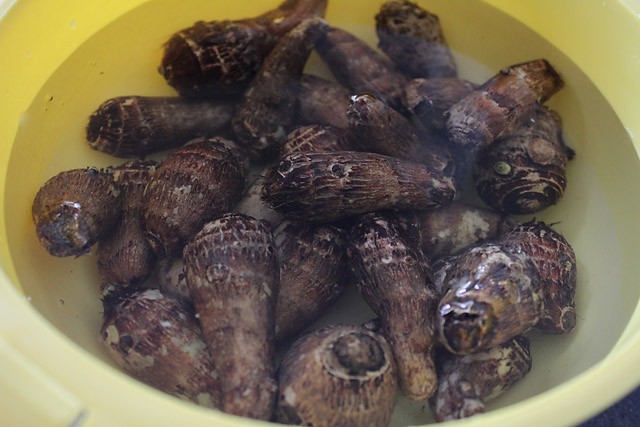
2. Once they are microwaved, let the arbi sit in the same bowl for some minutes.

3. Drain the water from the arbi and once they are warm, peel off the skin. Lightly press them to flatten between the palms of your hands.
These arbi were a little tough, so I just could not flatten them slightly. You can also chop them if you want.

Make Arbi Sabji
4. Shallow or deep fry the arbi in hot oil on medium heat. Take care not to burn them.
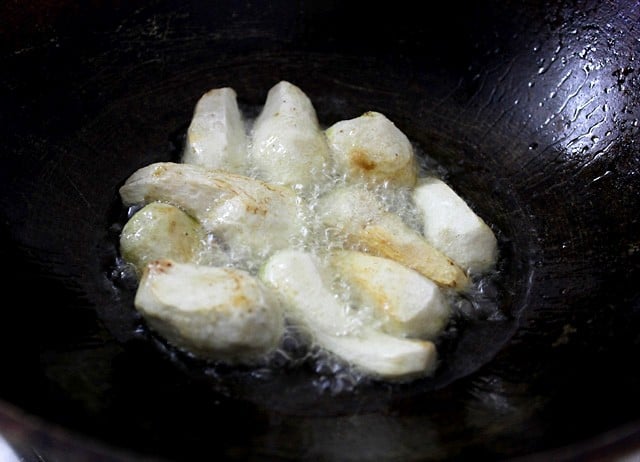
5. Drain the fried arbi on a kitchen napkin.

6. In another pan, heat little oil – about 1 to 2 teaspoons. Add the carom seeds and fry for a minute on low heat.
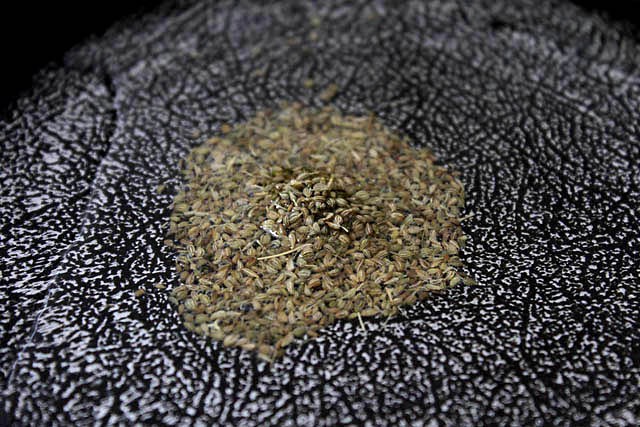
7. Keep the heat to the lowest (or opt to turn off the heat), add 1 teaspoon red chili powder and 1 teaspoon coriander powder. Ensure that the spice powders do not burn. Mix them well.

8. Add the fried arbi to the spice mixture. Toss the arbi uniformly in the spice mixture.
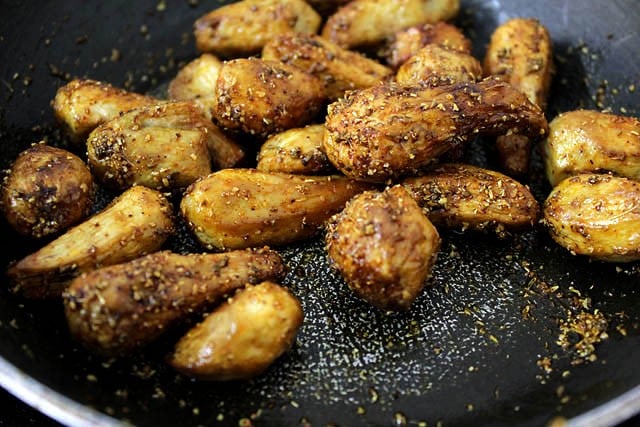
9. Add 1 teaspoon dried mango powder (amchur powder) and mix well.

10. Add edible rock salt as needed, if making this recipe for fasting or black salt or plain salt otherwise. Mix well.
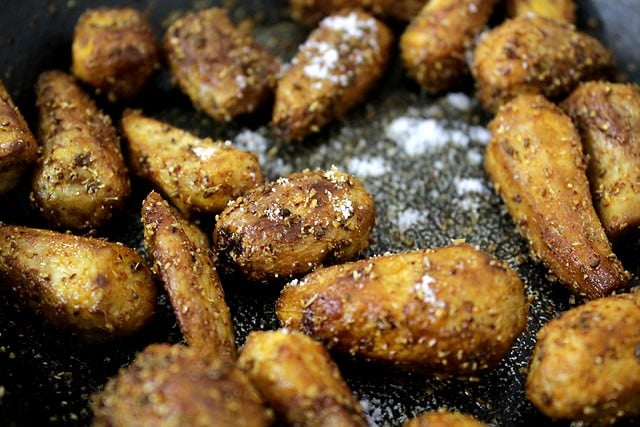
11. Lastly, add some chopped mint leaves to the Arbi Sabji. Easily swap mint with coriander leaves.

12. Serve Ghuiya ki Sabji hot with some phulka or just plain as a snack or starter.

Variations
I love the feedback and suggestions that I get from my readers. And sometimes, some of them are so good, that they must be shared so that they reach to a wider audience. All across the globe!
So, here are some of my handpicked dry Arbi Sabji variations shared by my readers. While I still may have not tried them all (trust me, I intend to!), but I really think that you must. It’s always good to have different flavor profiles of the same dish.
- A generous pinch of asafoetida (hing) can be added to the tadka for a subtle yet rustic twist in the taste. Then, pair it with crisp parathas and enjoy.
- There’s a Sindhi style of making the same arbi fry, may name it as Arbi Tuk. This is how you go about it: Boil arbi, peel and press slightly to get oblong tikki shaped boiled arbi pieces. Sprinkle some salt and keep them aside for a while. Proceed by deep-frying in hot oil till a nice golden. Douse the fried arbi pieces with a mixture of red chili powder, coriander powder and dried mango powder (amchur powder), serve. Make sure to consume these immediately after frying or else these will lose their crispness, will become soft and simply meh! Here’s the famous Aloo Tuk recipe for you.
- Another way of making it is by adding 1 to 2 tablespoons of rice powder, red chili powder, cumin powder and salt to the boiled arbi. Keep this to marinate for 30 minutes. Then, fry in little oil, garnish with curry leaves and relish.
Expert Tips
- Sometimes, colocasia or arbi may cause itchiness after coming in contact with the skin. So, while peeling and chopping the arbi, apply some oil on your fingers and palm.
- Fry the spice powders on the lowest heat. You can even switch off the heat, if need be. This is to avoid the burning of the spice powders.
- When preparing this recipe for vrat/fast, do not add asafoetida (hing). Use edible rock salt instead of regular salt.
More Fasting Recipes To Try!
Navratri & Fasting Recipes
Navratri & Fasting Recipes
Navratri & Fasting Recipes
Navratri & Fasting Recipes
Please be sure to rate the recipe in the recipe card or leave a comment below if you have made it. For more vegetarian inspirations, Sign Up for my emails or follow me on Instagram, Youtube, Facebook, Pinterest or Twitter.

Arbi Sabji | Arbi Recipe | Ghuiya Ki Sabji
Ingredients
- 250 grams colocasia roots (arbi or ghuiya or taro root)
- water as needed to cook arbi
- 1.5 teaspoon carom seeds (ajwain)
- 1 teaspoon Coriander Powder
- 1 teaspoon red chili powder or cayenne pepper
- 1 teaspoon dry mango powder (amchur)
- oil for frying, as needed
- 1 tablespoon chopped mint leaves or coriander leaves, for garnish
- rock salt (edible and food grade) or sendha namak if making for religious fast (or regular salt for other days)
Instructions
- First rinse the taro roots thoroughly under running water to remove any soil or mud from them. Then opt to Pressure cook, steam or microwave the taro roots till they are almost cooked and tender. Remember not to overcook the tarot roots as they will become too mushy and pasty.
- To cook in a microwave oven, take some water in a microwave safe bowl just about covering the arbi. Microwave on high for 5 to 6 minutes or more until the taro roots are almost cooked.
- For pressure cooking, in a 2 litre pressure cooker, add the arbi with water covering them entirely. Pressure cook on medium heat for 1 whistle. Let the pressure drop naturally in the cooker and then only open the lid.
- Drain all the water and let the arbi cool or become warm. Peel of the skins from each taro root.
- Now if you want then lightly press the arbi between your palms to flatten them slightly.
- Shallow or deep fry the arbi in moderately hot oil oil till golden brown.
- In another pan, add little oil – about 1 to 2 teaspoons
- Add the carom seeds and fry for a minute.
- Now add both the spice powders, coriander and red chili powder.
- Mix well and add the fried arbi to this seasoning. Mix the arbi well.
- Add amchur powder and salt. Mix again well.
- Garnish Arbi Sabji with some chopped mint leaves or coriander leaves and serve hot.
Notes
- While peeling the arbi, apply some oil to your fingers and peel.
- While frying the spice powders, do so at the lowest heat. If need be you can switch off the stove. The spice powders, especially chili powder tends to burn quickly on a high heat.
- The sukhi arbi can also be served as a snack or starter.
- If making for vrat or fast, then don’t add asafoetida (hing).
Nutrition Info (Approximate Values)
This Arbi Sabji recipe from the archives first published in February 2012 has been republished and updated on November 2022.

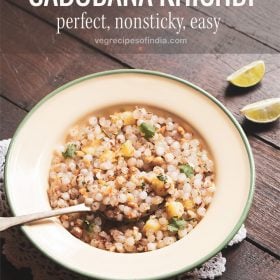











I loved this recipe alott….
My family also lyked it..
It’s super easy,.n too quick…thanx 4 sharing this recipe
welcome archana. glad to know that you all liked this sukhi arbi recipe.
Going to try this recipe tonight!!? Never had arbi in any form till now.. bought it today after going through the recipe last night.. I love your blog.. have learned so many dishes from you!! And got compliments every time..? thank you so much for sharing your recipes and helping me and many others!!
pleased to know this manju thankyou for your kind and encouraging words 🙂 god bless you.
I tried out this recipe and it was heavenly! Thanks so much for sharing the recipe.
welcome calla and thankyou so much 🙂
Hi Dassana,
I tried this reciepe. It was very nice and tasty. My hubby loves it.
glad your hubby loved it 🙂 thankyou